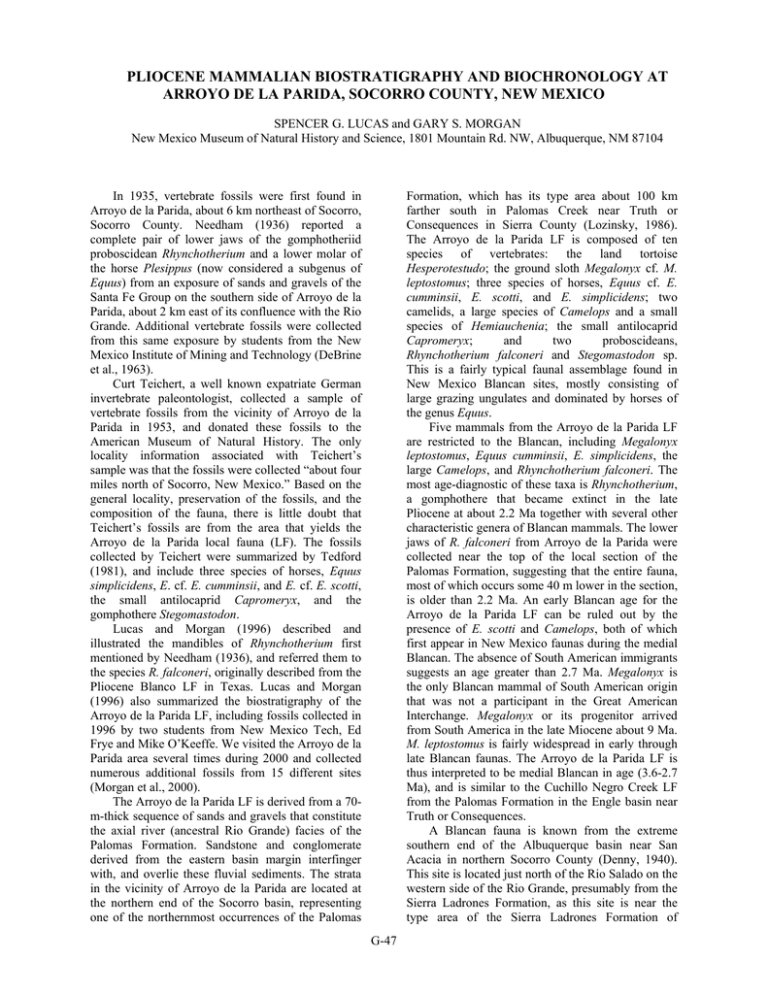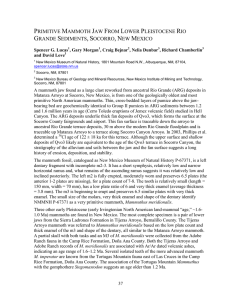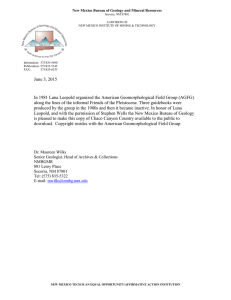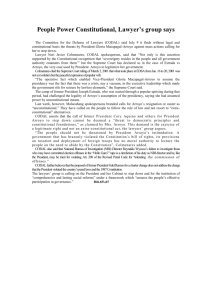PLIOCENE MAMMALIAN BIOSTRATIGRAPHY AND BIOCHRONOLOGY AT
advertisement

PLIOCENE MAMMALIAN BIOSTRATIGRAPHY AND BIOCHRONOLOGY AT ARROYO DE LA PARIDA, SOCORRO COUNTY, NEW MEXICO SPENCER G. LUCAS and GARY S. MORGAN New Mexico Museum of Natural History and Science, 1801 Mountain Rd. NW, Albuquerque, NM 87104 In 1935, vertebrate fossils were first found in Arroyo de la Parida, about 6 km northeast of Socorro, Socorro County. Needham (1936) reported a complete pair of lower jaws of the gomphotheriid proboscidean Rhynchotherium and a lower molar of the horse Plesippus (now considered a subgenus of Equus) from an exposure of sands and gravels of the Santa Fe Group on the southern side of Arroyo de la Parida, about 2 km east of its confluence with the Rio Grande. Additional vertebrate fossils were collected from this same exposure by students from the New Mexico Institute of Mining and Technology (DeBrine et al., 1963). Curt Teichert, a well known expatriate German invertebrate paleontologist, collected a sample of vertebrate fossils from the vicinity of Arroyo de la Parida in 1953, and donated these fossils to the American Museum of Natural History. The only locality information associated with Teichert’s sample was that the fossils were collected “about four miles north of Socorro, New Mexico.” Based on the general locality, preservation of the fossils, and the composition of the fauna, there is little doubt that Teichert’s fossils are from the area that yields the Arroyo de la Parida local fauna (LF). The fossils collected by Teichert were summarized by Tedford (1981), and include three species of horses, Equus simplicidens, E. cf. E. cumminsii, and E. cf. E. scotti, the small antilocaprid Capromeryx, and the gomphothere Stegomastodon. Lucas and Morgan (1996) described and illustrated the mandibles of Rhynchotherium first mentioned by Needham (1936), and referred them to the species R. falconeri, originally described from the Pliocene Blanco LF in Texas. Lucas and Morgan (1996) also summarized the biostratigraphy of the Arroyo de la Parida LF, including fossils collected in 1996 by two students from New Mexico Tech, Ed Frye and Mike O’Keeffe. We visited the Arroyo de la Parida area several times during 2000 and collected numerous additional fossils from 15 different sites (Morgan et al., 2000). The Arroyo de la Parida LF is derived from a 70m-thick sequence of sands and gravels that constitute the axial river (ancestral Rio Grande) facies of the Palomas Formation. Sandstone and conglomerate derived from the eastern basin margin interfinger with, and overlie these fluvial sediments. The strata in the vicinity of Arroyo de la Parida are located at the northern end of the Socorro basin, representing one of the northernmost occurrences of the Palomas Formation, which has its type area about 100 km farther south in Palomas Creek near Truth or Consequences in Sierra County (Lozinsky, 1986). The Arroyo de la Parida LF is composed of ten species of vertebrates: the land tortoise Hesperotestudo; the ground sloth Megalonyx cf. M. leptostomus; three species of horses, Equus cf. E. cumminsii, E. scotti, and E. simplicidens; two camelids, a large species of Camelops and a small species of Hemiauchenia; the small antilocaprid Capromeryx; and two proboscideans, Rhynchotherium falconeri and Stegomastodon sp. This is a fairly typical faunal assemblage found in New Mexico Blancan sites, mostly consisting of large grazing ungulates and dominated by horses of the genus Equus. Five mammals from the Arroyo de la Parida LF are restricted to the Blancan, including Megalonyx leptostomus, Equus cumminsii, E. simplicidens, the large Camelops, and Rhynchotherium falconeri. The most age-diagnostic of these taxa is Rhynchotherium, a gomphothere that became extinct in the late Pliocene at about 2.2 Ma together with several other characteristic genera of Blancan mammals. The lower jaws of R. falconeri from Arroyo de la Parida were collected near the top of the local section of the Palomas Formation, suggesting that the entire fauna, most of which occurs some 40 m lower in the section, is older than 2.2 Ma. An early Blancan age for the Arroyo de la Parida LF can be ruled out by the presence of E. scotti and Camelops, both of which first appear in New Mexico faunas during the medial Blancan. The absence of South American immigrants suggests an age greater than 2.7 Ma. Megalonyx is the only Blancan mammal of South American origin that was not a participant in the Great American Interchange. Megalonyx or its progenitor arrived from South America in the late Miocene about 9 Ma. M. leptostomus is fairly widespread in early through late Blancan faunas. The Arroyo de la Parida LF is thus interpreted to be medial Blancan in age (3.6-2.7 Ma), and is similar to the Cuchillo Negro Creek LF from the Palomas Formation in the Engle basin near Truth or Consequences. A Blancan fauna is known from the extreme southern end of the Albuquerque basin near San Acacia in northern Socorro County (Denny, 1940). This site is located just north of the Rio Salado on the western side of the Rio Grande, presumably from the Sierra Ladrones Formation, as this site is near the type area of the Sierra Ladrones Formation of G-47 NMBMMR OFR 454B Machette (1978). The fauna reported by Denny (1940, p. 93) from the San Acacia site consists of the gomphothere Stegomastodon mirificus and an undetermined species of Equus. We have not examined these fossils, so the identifications are taken from Denny’s paper and must be considered tentative. The San Acacia site is similar to the middle to late Blancan Arroyo de la Parida local fauna, derived from the Palomas Formation about 15 km farther south in the northern part of the Socorro basin (Tedford, 1981; Lucas and Morgan, 1996). REFERENCES DeBrine, B., Spiegel, Z., and William, D., 1963, Cenozoic sedimentary rocks in Socorro Valley, New Mexico: New Mexico Geological Society, Guidebook 14, p. 123131. G-48 Denny, C.S, 1940, Tertiary geology of San Acacia area: Journal of Geology, v. 48, p. 73-106. Lozinsky, R. P.,1986, Geology and late Cenozoic history of the Elephant Butte area, Sierra County, New Mexico: New Mexico Bureau of Mines and Mineral Resources Circular 187, p. 1-40. Lucas, S. G. and Morgan, G. S., 1996, The Pliocene proboscidean Rhynchotherium (Mammalia: Gomphotheriidae) from south-central New Mexico: Texas Journal of Science, v. 48, p. 311-318. Morgan, G. S., Lucas, S. G., Sealey, P. L., Connell, S. D., and Love, D. W., 2000, Pliocene (Blancan) vertebrates from the Palomas Formation, Arroyo de la Parida, Socorro basin, central New Mexico: New Mexico Geology, v. 22, p. 47. Needham, C. E., 1936, Vertebrate remains from Cenozoic rocks: Science, v. 84, p. 537. Tedford, R. H., 1981, Mammalian biochronology of the late Cenozoic basins of New Mexico: Geological Society of America Bulletin, v. 92, p. 1008-1022.






